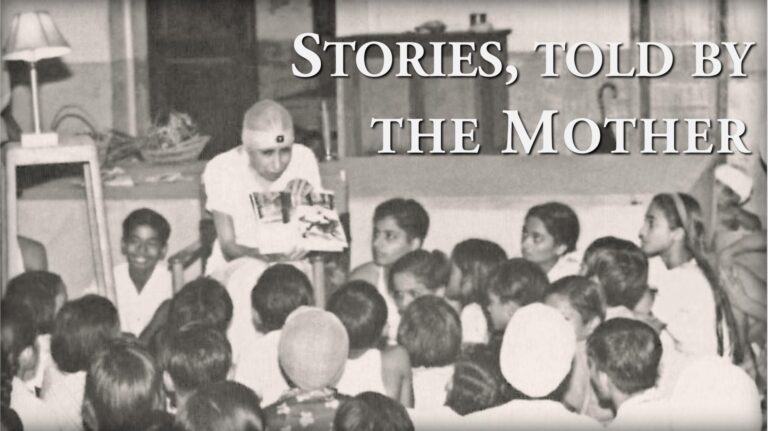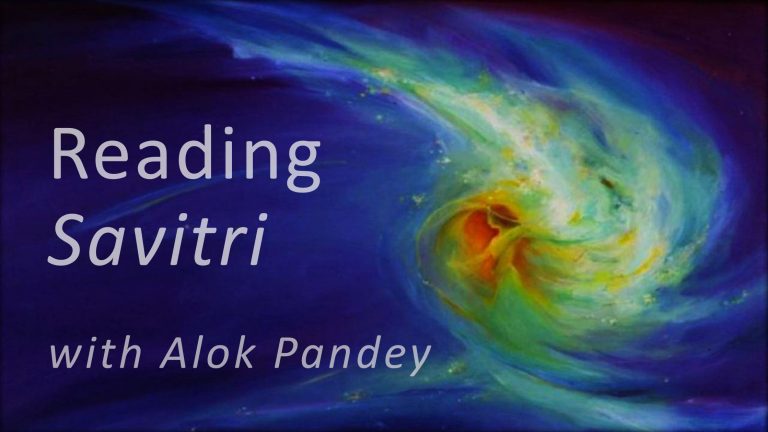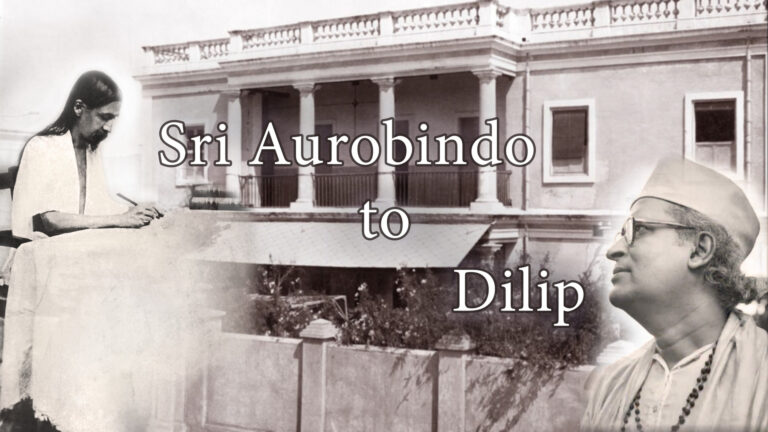A series of talks by Prof. Mangesh V. Nadkarni on Sri Aurobindo’s Savitri in Pondicherry in 1995.
There are those who worry that if they turn to spiritual life, they will lose their individuality. Your individuality is the one sacred thing about you, but you don’t now know what your individuality is.
You are now hugging a surface individuality, a borrowed individuality as your own. When you discard this and take your stand on the locus of your own inner being and then progress, then you participate in this becoming. Then, says Sri Aurobindo, this person will be established here, he will be a unique manifestation of the Divine. Each one of us has a sacred right to our personality, to our individuality. No two leaves are alike, no two individuals are alike; each one of us is a unique manifestation of the Divine.
Therefore, Sri Aurobindo says,
This constant will she covered with her sport,
To evoke a Person in the impersonal Void,
With the Truth-Light strike earth’s massive roots of trance,
Wake a dumb self in the inconscient depths
And raise a lost Power from its python sleep
That the eyes of the Timeless might look out from Time
And the world manifest the unveiled Divine.
Bk 1, Canto 4, p. 72-73
It is for this perfection, for this perfect manifestation, that we have come here.
For this he left his white infinity
And laid on the spirit the burden of the flesh,
That Godhead’s seed might flower in mindless Space.
Bk 1, Canto 4, p. 73
We’ll now move on to Book II. As you can see from the contents page, Book II—The Book of the Traveller of the Worlds—is the largest book in the epic. It consists of 15 cantos. This is a book where Aswapati is undertaking a journey, a journey of several planes of consciousness and these several planes of consciousness are called various worlds. So Aswapati explores the various worlds.
What are these worlds, why is this exploration necessary, what is it that Aswapati hopes to find through this exploration? These are things about which a few words may be said at this point. These are worlds representing the various planes of consciousness. Probably you know that Sri Aurobindo accepts the notion of evolution, not Darwin’s notion of evolution, but he argues that this entire creation becomes meaningful if you look at it as a spiritual evolution of consciousness. What is happening here is a spiritual evolution of consciousness, this whole world is that—an evolution from the inconscient to the superconscient, from matter to the Divine—that is the journey. If this entire journey has to be undertaken, you can’t finish it in one life. Therefore, in Sri Aurobindo’s approach, the individual’s rebirth is a fundamental aspect. Because in one life, as we know, we make so little progress; but the progress that has to be attained here is from the inconscient to the superconscient. So rebirth, an individual coming here again and again in different physical forms, is a basic tenet of Sri Aurobindo’s metaphysical belief.
Now, this idea of spiritual evolution says that this world that you and I inhabit is not autonomous, it is not self-contained. This world is part of a cosmic scheme. The whole idea becomes easier to understand if you regard the creation itself as an embodiment of the Divine. There is the notion of God having created this world, and when you say God creates this world, very often we tend to think of it it like a potter creates a pot. When a potter creates a pot the material he uses for creating the pot is not his own body, but something else outside the potter. The pot is not part of the potter. So when the pot is broken, nothing happens to the potter, the potter is independent of the pot. In the Vedantic concept where it talks about creation—in some schools of Vedanta there is no talk of creation—it looks upon creation as a self-projection of the Divine. The Divine created the world means in effect that the Divine became the world.
How did the Divine become the world? The whole Vedantic idea is the one becoming the many. For God, who as we describe him is sat chit ananda, to become inconscient, this plunge couldn’t have been a sudden plunge. What must have happened is, just as we talk about evolution, Sri Aurobindo talks about a process of involution before evolution takes place. God takes a plunge, that is, all the effulgence, all the glory, all the superconscient characteristics of God’s being, gradually diminish, gradually lose their power. So there is a descending stair, as it were, along which the Divine descends until he becomes the inconscient. These various descending stairs are the various worlds.
Sri Aurobindo talks about worlds at seven levels—matter, life, mind—this is the lower hemisphere; then you have the worlds of ananda, chit and sat—these are the worlds of the higher level. Intermediate between these two is the world of the supermind. So there are seven levels, and these seven levels are known to the Indian tradition—it talks about seven rivers, seven life forces, seven rishis—there is always this number seven. These are the seven worlds. The superconscient became the inconscient along these steps, as it were.
For several billion years after the big bang nothing could be formed, there was such a chaotic flow of energy. Even the sun couldn’t cohere. Gradually this flow of energy formulated itself into this earth. And when the earth came, there was nothing here; there was no life, no mind, no human being. It was what we may call a vast desert, but notice it was only seeming desert, for this earth itself, this so-called inconscient, is another form of the superconscient, another form of the Divine. And because the Divine is already implicit here, already hidden here, it is inevitable that gradually, one by one, the Divine unfolds his consciousness. The first level came when life came up. Now why should life come from matter? I don’t think the Darwinians would have any answer. They would probably say life came because life came, there is nothing to explain, or they may say that life is nothing but a complex form of matter. But those days are gone, they don’t have that kind of confidence any more. They say life is not just matter, there is something else that makes for life. How that comes we don’t know.
Sri Aurobindo is very clear. Life comes from matter because life is already involved in matter, life is simply released from matter. Similarly, mind comes from life because mind is already involved in life. And in the same way higher and higher levels of consciousness are bound to be revealed until at last the superconscient Divine is also going to be revealed here, because that also is already involved. Evolution, therefore, is an inevitable result of involution. This is the basic idea and Sri Aurobindo believes that this world, this earth is not autonomous.
In many ways, Sri Aurobindo himself says we don’t need the mechanical Darwinian theory of evolution. For 100 years since Darwin’s theory, of course, modern science accepts the basic notion of evolution, but many of the things Darwin talked about are not anymore acceptable. The idea that there are gaps, missing links in the record of evolution, for example, make Darwinian theory in its details unacceptable.
Spiritual evolution is basically an evolution of consciousness, it’s not an evolution of form. Science at best can talk about the evolution of form. Sri Aurobindo says the evolution of form is secondary, what is primary is the evolution of consciousness. When consciousness emerges, as you can see, the consciousness becomes more and more independent.
Take, for example, a handful of earth or a rock and compare it with a plant. The plant also ultimately is matter, you can’t question that, but it’s a different grade of matter. It is a kind of matter which has learnt how to draw sustenance with its roots from the earth, sustenance from the sun, from the rain, and how to convert this energy into leaves, branches, flowers, fruit and how to multiply itself. All this a plant can do. When life emerges, consciousness emerges; it is a different kind of matter. Something else has been added to it.
Similarly, when mind comes, like in an animal, it is more expressive than the plant. If you cut the branch of a plant, it feels hurt, but it can’t express itself. It has to suffer whatever you do to it silently. But an animal is more free; it can bark at you, it can run away from you. The consciousness in man is still more free. Man is freer than an animal, an animal is freer than a tree, a tree is freer than a handful of earth. What is happening here is that consciousness is gradually unfolding itself.
What is the difference between a chimpanzee and man? The difference is just this: that man has what is called the mental consciousness. The chimpanzee has it in a very elementary form. As a result, you really have to work hard to teach a chimpanzee how to speak any kind of language. People have tried and not really succeeded, but in the case of a human being, it is difficult for a human child not to learn a language. Learning a language becomes absolutely natural to him. How did this happen? There is a consciousness called the mind that has come. As a result, all these faculties have come.
This is the evolutionary process. For this evolution to take place―as I said, this world is not autonomous, this world is not self-sufficient―influences from other worlds keep impinging on this world. You always have influences acting on this world. Now this belief in other worlds is not peculiar to Sri Aurobindo or to Hindu thought. All religions have talked about other worlds. Here, Sri Aurobindo accepts these other worlds as very real, but where are these worlds—where is the world of life, where is the world of mind, in which map can we find them, which travel agent will enable you to go to these places? These are questions based on a primary misunderstanding. This world is a world made out of matter, but matter is not the only kind of substance. There are other kinds of substances, and some are finer than matter. Life is a substance, mind is a substance, bliss is a substance, consciousness-force can be a substance. So these different worlds that we talked about are not made of matter at all. There is only one material world which you and I know. These other worlds that we talk about are finer worlds, they are larger worlds, but they are not material worlds. They are worlds of life, worlds of mind, worlds of finer substances.
Later, we’ll find that Aswapati sees a whole series of worlds piled up one on top of the other. This is what he sees before he starts on his journey. And it is Sri Aurobindo’s belief that before life can manifest here, two things have to happen. One is that there has to be sufficient readiness in the earth consciousness to receive life, and the second is that there has to be a response from the life world. Life responds to this aspiration of the earth consciousness, and life comes here. There is a constant interaction between our world and the other worlds. Very often, there is an interaction between forces from the other worlds and our lives but we don’t know it. Unless you have occult knowledge you won’t know what mischievous forces from other worlds are capable of creating things here. Sometimes terrible things happen as a result of this mischief that is coming from other worlds.
Take, for example, the Second World War. It had an occult origin and it is not something that can be explained very simply. At one time nobody took Hitler very seriously, but now that people have looked at records and what kinds of things that Hitler did, people now know that whatever Hitler did was not something he himself invented, he had occult guidance from Asuric and non-divine forces. So very often this world becomes a playfield of all these forces.
Now, there are these worlds, and if you do occult practices, if you are an adept in this, you can leave your body here and travel, go to the various occult worlds. Mother in many of her writings talks about her visits to these occult worlds. It is possible, but it is not necessary.
Now Aswapati, being a yogi, wants to find out why it is that all the efforts of man to find perfection here on earth have failed. Is there anything wrong with the kind of things that come to us from other sources? So he undertakes an exploration of all these different worlds, beginning with the subtle physical world. Then he comes to the various vital worlds, the mental worlds, the worlds beyond the mind, and he tries to find out if there is any principle, any secret which we can borrow from these worlds that will help man to transcend his present limitations. He finally comes to the conclusion that there is nothing here really that can help man, to find this principle man has to go to the transcendental source, and that is why he turns to the Divine Mother.
Thus, this second book is an exploration of these various worlds, and we will begin with Canto 1, which is called “The World Stair.” These 15 cantos are very difficult, partly because they describe experiences which are extraordinary and purely yogic experiences. There is almost an encyclopaedia of occult knowledge here. You and I have never been there and therefore we kind of gape in wonder, but let me tell you, any time you spend looking at these cantos will be very rewarding because in many places Sri Aurobindo, through sheer poetry, recreates the experiences of these worlds, and you will see, you will understand, many things.
For example, when he looks at the world of life, he finds that desire is very basic to life. We all want to get rid of desire. Everybody says, “if you want to be a yogi, you shouldn’t have desires.” But it’s very interesting, if you look at the vital world, as Sri Aurobindo does, he points out the great role desire played in the evolutionary journey. Everything after a certain time becomes unnecessary, and you have to discard it. But in God’s world there is nothing that is really superfluous. If you are tormented by desire, it is simply because at a certain stage in our evolution desire was the only thing that saved us, this instinct to survive, the instinct to propagate, the will to live here, because we are all surrounded by death on all sides and in the early stages, the flag of evolution was carried by desire. As Sri Aurobindo says, Desire was the helper, desire is the bar. At a certain stage in evolution, desire becomes a bar, but at an earlier stage of evolution, desire was a helper. So if you look at all these stages, as Sri Aurobindo does, your perspective of life is completely changed. You don’t blame anything. Sri Aurobindo says: Ego was the helper, ego is the bar. Ego becomes a bar when the time has come for you to transcend the limitations of mental life and go beyond the mind, then the ego is a bar; but in the earlier stages, ego was what gave you a personality. Therefore, for a clear understanding of the evolutionary history, how man developed, along what lines, this is a wonderful guidebook.
But let me assure you, this requires tremendous patience, going back again and again, reading several times. Most people give this advice: “Avoid Book 2. You’ll come back to it when you must. Don’t be in a hurry to come to Book 2.” But here we decided that we will follow the chronological order, we’ll do Book 1 first and then Book 2. This is Sri Aurobindo’s journey, so we will get to know something of it.
This is a brief background to what these worlds are, why Aswapati does what he is doing, and why then he has to go beyond the worlds, to the transcendent Supreme Mahashakti, and ask her to send something here which the world does not yet have. That is why he goes to the Supreme Mother in Book 3. But before that, we will see a little bit of Book 2. I have decided to devote to this just two talks―even 20 talks would not be adequate―just to give you some idea what this is all about.
Let us look at the very first canto where we get some idea of what this is all about:
There walled apart by its own innerness
In a mystical barrage of dynamic light
He saw a lone immense high-curved world-pile
Erect like a mountain-chariot of the Gods
Motionless under an inscrutable sky.
Bk 2, Canto 1, p. 98
This is what Aswapati sees, a pile of worlds, worlds upon worlds, like a chariot of the gods.
As if from Matter’s plinth and viewless base
To a top as viewless, a carved sea of worlds
Climbing with foam-maned waves to the Supreme
Ascended towards breadths immeasurable;
It hoped to soar into the Ineffable’s reign:
A hundred levels raised it to the Unknown.
Bk 2, Canto 1, p. 98
How many worlds were there? Hundreds of them, not one or two, but they basically belong to seven planes of consciousness. How did Aswapati go into this world?
There is something very interesting. The microcosm and the macrocosm, the world outside and the world within man have more or less the same structure. So if you want to understand the structure of the world outside, the vital worlds, the mental worlds, you don’t have to go anywhere except within you. So Aswapati goes within his own consciousness to explore these other worlds. That’s why he says:
A summary of the stages of the spirit,
Its copy of the cosmic hierarchies
Refashioned in our secret air of self
A subtle pattern of the universe.
Bk 2, Canto 1, p. 98
A subtle pattern of the universal structure is also found within the structure of our own consciousness. So Aswapati doesn’t go anywhere; he goes within himself. By going within himself he is able to explore the various worlds. Where does he go?
It is within, below, without, above.
What is this? Consciousness. The basic reality behind this entire universe, this creation, is consciousness.
Acting upon this visible Nature’s scheme
It wakens our earth-matter’s heavy doze
To think and feel and to react to joy;
It models in us our diviner parts,
Lifts mortal mind into a greater air,
Makes yearn this life of flesh to intangible aims,
Links the body’s death with immortality’s call:
Out of the swoon of the Inconscience
It labours towards a superconscient Light.
Bk 2, Canto 1, p. 98-99
Out of the swoon of the inconscience up to the superconscient it is consciousness, it is a stairway of consciousness that you find here.
If earth were all and this were not in her,
Thought could not be nor life-delight’s response:
Only material forms could then be her guests
Driven by an inanimate world-force.
Bk 2, Canto 1, p. 99
If earth were all then the materialists would be right. But we can’t say that anymore, because we have other worlds, other realities. And all these realities are made of one thing, and that is consciousness. These are various manifestations of consciousness. The inconscient is one end of this consciousness, the Divine is the other end. So there is nothing which is non-divine, here even matter is Divine. Therefore you do not have to deny matter to accept the spirit; both are two ends of the same reality, two manifestations of the same reality with intermediate links between them: matter, life, mind, supermind, and the world of bliss, consciousness force and truth. This is what is described here.
Earth by this golden superfluity
Bore thinking man and more than man shall bear;
Bk 2, Canto 1, p. 99
Because of this, out of a handful of dust as it were, Nature has been able to fabricate man. And because of this presence of consciousness, more than man it shall bear. A creature greater than man will one day arrive here, that is for certain. So Sri Aurobindo says,
Earth by this golden superfluity
Bore thinking man and more than man shall bear;
This higher scheme of being is our cause
And holds the key to our ascending fate;
Bk 2, Canto 1, p. 99
This is the secret of evolution: consciousness gradually ascending, manifesting higher and higher grades of its own beauty, its own strength, its own awareness.
How did this world of inconscience come about? That also is explained on page 99.
Once in the vigil of a deathless gaze
These grades had marked her giant downward plunge,
The wide and prone leap of a godhead’s fall.
Bk 2, Canto 1, p. 99
That is why our life is a holocaust of the Supreme. The Supreme has sacrificed Himself and become this world.
The great World-Mother by her sacrifice
Has made her soul the body of our state;
Accepting sorrow and unconsciousness
Divinity’s lapse from its own splendours wove
The many-patterned ground of all we are.
Bk 2, Canto 1, p. 99
All that we are here is ultimately from that Supreme, it is the Divine Mother’s holocaust, it is the purusha’s holocaust, that has created this world.



